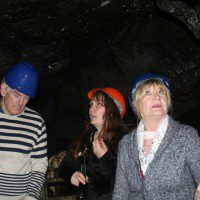As the nation prepares for the bicentenary of the Battle of Waterloo on June 18, a small museum is beating its own drum in celebration of its close connections to this important historical event.
The current exhibition at the Museum of Lead Mining in Wanlockhead showcases a number of direct links between the area and the famous showdown in Belgium which destroyed Napoleon Bonaparte’s vision of becoming emperor of Europe and forced him into exile on to St Helena, where he died in 1821.

In this special exhibition, weapons, ammunition, newspaper articles and other memorabilia of the time sit alongside a special regimental drum which was used in the battle almost two centuries ago and the display has been created around this drum.

Museum spokesman, and exhibition mastermind, Gerard Godfrey, said: “The provenance of this drum is impeccable.
“It was gifted to the Wanlockhead Miner’s Library in 1820 by Lieutenant John Bramwell who had been recently married to Agnes Bramwell, his first cousin.
“Agnes was the daughter of the manager of the mines at Wanlockhead. The Battle of Waterloo had been seen by contemporaries as a great victory over the tyrant Napoleon Bonaparte and souvenirs were highly prized.
“The Miners’ Library was probably the only institution in the area where this relic of the battle could be safeguarded for posterity. The drum, as you would expect is in a very fragile condition.
“Bramwell had fought at the Battle of Quatre Bras on 16 June, two days before Waterloo. He was severely injured and had one of his legs amputated as a result. He was invalided out of the army and came to settle in Sanquhar. It is not known how he had obtained the drum.”
Other artefacts shown in the display are a cavalry sabre found in the attic of a house in Leadhills in 2004.
Gerard said: “Although similar, this sabre is a much later version of those used at Waterloo. It is slightly heavier, has a longer blade and better protection for the soldier’s hand.
Gerard explained: “About ten years ago the cavalry sabre was found in the attic of the Old Post Office at Leadhills.
“Almost as interesting as the newspaper article is the price of the newspaper, which was ten pence plus three pence newspaper tax. These amounts are very substantial. The total cost of buying the paper exceeded the working man’s wage for the day!”
Lead was a significant metal in 19th century military artillery and the area’s mines, rich in the substance, were an important source.
Gerard added: “In the 19th century there was a direct link between the battlefield and the lead mines at Wanlockhead and Leadhills.
“Lead was used to manufacture munitions and the musket balls on display illustrate this lethal use of lead.”
The Waterloo display also illustrates the progress of the battle and shows the number of combatants and casualties within the three armies involved.











